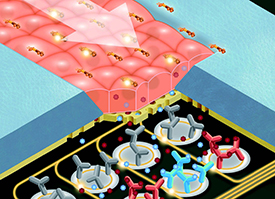Benjamin Miller Lab
Molecular Recognition & Biosensing
Research in the Miller group focuses on two fundamental areas: the control of biomolecular interactions through the synthesis of new small-molecule probes, and the observation of biomolecular interactions through the development of novel optical sensing technologies. In the area of control, we are particularly interested in the sequence-selective recognition of RNA. New RNA sequences with important functions in basic biology and human health and disease are being discovered at an ever-increasing rate, and yet our ability to target these sequences specifically is still at a rudimentary stage. To address this gap, we are applying techniques of molecular design and a novel combinatorial method of small-molecule evolution called Dynamic Combinatorial Chemistry, which allows us to rapidly prototype sequence-selective RNA binding molecules. Thus far we have used this methodology to RNA targets important in Myotonic Dystrophy and HIV. Protein-targeted small-molecule discovery projects are also of interest, and current projects include the mechanism of tight junction formation and the transport of beta-amyloid across the blood-brain barrier.
To the end of achieving better methods of observing biomolecular interactions, our group has a longstanding program in the use of the optical properties of nanostructured materials as the basis for new biosensors and diagnostic tools. Two examples of current efforts include Arrayed Imaging Reflectometry (AIR) and sensors based on two-dimensional photonic crystals (2-D PhC). AIR relies on the creation of a near-perfect antireflection coating on the surface of a silicon chip; binding of a biomolecular target destroys this antireflective condition and is visible by a change in reflected light. This allows for highly multiplexed (10's to 1000's of targets) and quantitative detection. Photonic crystal sensors, on the other hand, offer the possibility of ultrasensitive detection: for example, a major long-term goal of our work is the production of sensors that can effectively detect one virus in a blood sample.
 Graduate Student John Cognetti’s Research Featured on Inside-Cover of Lab on a Chip
Graduate Student John Cognetti’s Research Featured on Inside-Cover of Lab on a Chip
A photonic biosensor-integrated tissue chip platform for real-time sensing of lung epithelial inflammatory markers
- Lambda Theta Reflectometry: A New Technique for Measuring Optical Film Thickness in Planar Protein Arrays.; ACS sensors. 2025 Jul 02.
- Lambda Theta Reflectometry: a new technique to measure optical film thickness applied to planar protein arrays.; bioRxiv : the preprint server for biology. 2025 Mar 29.
- Everything's under Control: Maximizing Biosensor Performance through Negative Control Probe Selection.; Analytical chemistry. 2025 Feb 03.
- Fluid flow impacts endothelial-monocyte interactions in a model of vascular inflammatory fibrosis.; Scientific reports; Vol 15(1), pp. 3227. 2025 Jan 25.
News
Affiliations
- Biochemistry & Biophysics
- Biomedical Engineering
- Dermatology
- Center for AIDS Research
- Del Monte Institute for Neuroscience
- NIH T32 Training Grant in Cellular, Biochemical & Molecular Sciences
- NIH T32 Training Grant in Immunology
- Biochemistry & Molecular Biology Ph.D. Program
- Biomedical Engineering Ph.D. Program
- Biophysics, Structural & Computational Biology Ph.D. Program
October 16, 2024
Scientists Developing Microchips with Brain and Lung Tissue to Study Viral Neuroinflammation
January 9, 2024
New NIH-funded Center Could Soon Reduce the Need for Pharmaceutical Trials on Animals
June 15, 2023
Miller Lab Welcomes Undergraduate Sara Boyer
April 12, 2023
Gabrielle Kosoy, Biophysics PhD Candidate in Dr. Ben Miller's Lab, wins 2nd place in UR Three Minute Thesis (3MT) Competition
Contact Us
Benjamin Miller Lab
MC 5-6141A
601 Elmwood Ave
Rochester, NY 14642











